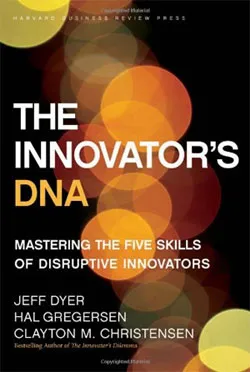[Book Review] The Innovator's DNA: Mastering the Five Skills of Disruptive Innovators
Jeff Dyer, Hal Gregersen and Clayton M. Christensen
2011 Harvard Business Review Press (Amazon)
10 chapters; 296 pages
This is a highly recommended book for personal and organisational development for all those interested in mastering techniques and mindsets of innovation. The material makes for an interesting and informative read, backed with lots of examples and self-assessment tables. The book also has an online companion with useful charts and questionnaires (www.InnovatorsDNA.com).

Jeffrey Dyer is the professor of strategy at Brigham Young University. Hal Gregersen is a professor of leadership at INSEAD. Clayton M. Christensen is a professor atHarvardBusinessSchool and the leading authority on disruptive innovation; his previous books include The Innovator’s Dilemma and The Innovator’s Solution.
The book is based on extensive research over eight years, covering hundreds of interviews and case profiles, and spearheaded by three leading authorities on innovation. If creativity and competitiveness are on your agenda, this book should definitely be on your table.
Companies that are seen as innovators command an "innovation premium" in the market; they not only adapt to changing conditions, but lead the way through them. While there certainly is a case to be made for the importance of artistic creativity, the authors show that business creativity is also crucial – and can be understood, practised and mastered.
The range of profiles cover the usual suspects and several others: Steve Jobs, Jeff Bezos, Michael Dell, Richard Branson, Howard Schultz (Starbucks), Scott Cook (Intuit), Peter Thiel (PayPal), Pierre Omidyar (eBay), and Niklas Zennstrom (Skype). Companies featured also include Alstom, Hindustan Lever, SalesForce.com, Tata Motors and Intuitive Surgical.
The authors make distinctions between incremental and disruptive innovation; competency-enhancing and competency-destroying technological changes; modular and architectural innovations; sustaining and disruptive innovations. The authors classify innovators into four types: startup entrepreneurs, corporate entrepreneurs, product innovators and process innovators. Not all entrepreneurs can be regarded as innovative.
Innovators have the courage to innovate: which consists of challenging the status quo, and being willing to take risks. Innovators have an important cognitive skill: associational thinking, or synthesising novel thoughts by connecting diverse inputs and fields. This cognitive skill can be sharpened by four behavioural skills: questioning, observing, networking and experimenting.
Five chapters in the book are devoted to these skills. I have summarised these principles and activities, along with some examples, in Table 1 below; the full chapters make for a more detailed and interesting read of course.
Table 1: The Innovator’s DNA: Skills and Tips
Inquiry-based living and learning means one should not be afraid of looking stupid by asking dumb or uncomfortable or controversial questions: which can be a problem in some cultures, the authors observe.
Mistakes are nothing to be ashamed of for an innovator. IDEO’s slogan is to ‘fail often to succeed sooner.’ Google defines ‘good failures’ as ones where you know why you failed, where you learned relevant knowledge for the next project, and which are not big enough to damage the brand.
A good methodology designed by Alex Osborn and Bon Eberle for rethinking and recombining ideas goes by the acronym SCAMPER: substitute, combone, adapt, magnifiy/minimise, put to other users, eliminate, reverse/rearrange.
“An idea mundane in one group can be valuable insight in another,” the authors recommend, as a reason to use networking to bridge structural holes or gaps between networks and idea spaces. For example, both Steve Jobs and Marc Benioff (Salesforce.com) took spiritual trips toIndiafor new insights.
Networking produces serendipity, and thus lucky entrepreneurs make themselves stumble onto ideas. For example, one of the innovative features that Steve Jobs wanted in the Apple II was a powering mechanism that did not require a fan because he found the noise of a desktop computer to be distracting. He got the ideas for the OS and user interface from a visit to Xerox PARC. The use of fonts came from a college calligraphy class. Through networking activities he came across the company Industrial Light and Magic, which he bought and renamed as Pixar.
Innovative thinking has transformed not just companies but entire industries. The scale and speed of innovation capacity in an organisation largely depends on the leadership’s commitment to innovation in terms of resources, recruitment, processes, culture and business strategy.
Companies need a mix of managers with discovery and delivery skills; particularly innovative companies, though, have top managers with a strong component of discovery skills, unlike mainstream companies. Unfortunately, business schools teach people how to be deliverers and not discoverers, the authors lament.
The second part of the book describes how innovative business leaders have transformed their entire companies into becoming more innovative, by shaping their people, processes and philosophies (or cultures). Four chapters are devoted to these DNA principles of innovative companies, and I have summarised them in Table 2 below.
Table 2: DNA of Innovative Companies
The book ends with a call to readers to take the innovation message and method to the next generation: children. They suggest that parents ask their children not just what they did in school, but what they asked in school. Read creative books with children, play word games with them. Take children to workplaces; get them to meet kids from different backgrounds. Take them to flea markets and dismantle or make things together. Take them on trips.
“Act different to think different,” the authors succinctly sum up.
The book has many insightful quotes about innovation; here are some of my favourite quotes below.
"Question the unquestionable." - Ratan Tata
"I haven't failed; I've just found 10,000 ways that do not work." - Thomas Edison
“Creativity thrives best when constrained.” – Marissa Mayer
“You don’t invent the answers; you reveal the answers by finding the right question.” – Jonas Salk
“Observing is the big game changer in our company.” – Scott Cook
“The anthropologist’s role is the single biggest source of innovation at IDEO.” – Tom Kelley
“If a picture is worth a thousand words, then a prototype is worth a million words.” – David Kelley
“Innovation is part and parcel with going down blind alleys.” – Jeff Bezos
“Companies are like sharks. If they stop moving, they die.” – Marc Benioff
[Follow YourStory's research director Madanmohan Rao on Twitter]






![[Book Review] The Innovator's DNA: Mastering the Five Skills of Disruptive Innovators](https://images.yourstory.com/cs/wordpress/2013/01/innovators_dna.jpg?mode=crop&crop=faces&ar=2:1?width=3840&q=75)

